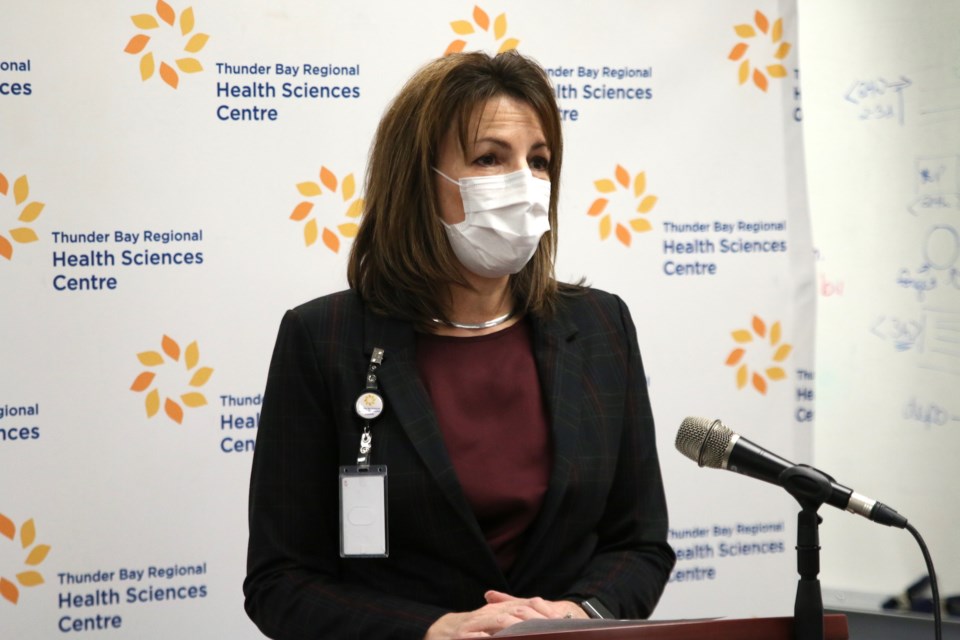THUNDER BAY — The head of Thunder Bay’s regional hospital says the institution may need to once again delay less urgent procedures and create special units this winter, facing a resurgent flu and a potential spike in COVID-19 cases.
Rhonda Crocker Ellacott, president of the Thunder Bay Regional Health Sciences Centre, said in a Wednesday interview the hospital is still being “significantly” impacted by COVID-19.
“The confluence of adding early [surge] of the seasonal flu onto that has meant there’s a significant increase in the number of patients presenting in the emergency department with respiratory illness,” she said. “It’s flu, it’s COVID, it’s other respiratory illnesses.”
The hospital’s emergency department, which she said typically sees 250 to 260 patients a day, had 309 in one day earlier this week.
That’s been driven in part by a flu season that’s expected to be more severe this year.
“We’ve already begun to see that over the last seven to 10 days, there’s significant case presentations in the emergency department with seasonal flu,” said Crocker Ellacott.
Those have involved children under 11 and those over 65 in particular, she added.
While the number of COVID-positive patients remains far from highs seen earlier in the pandemic, the virus has had a larger impact this fall than last. The hospital admitted an average of one COVID-positive patient a day in October 2021. This year, the average was 32 a day.
There were a total of 40 patients testing positive for COVID-19 in hospital as of Wednesday, with one of those in the intensive care unit.
Even if the majority — around 80 per cent — are now admitted for reasons other than COVID-19, and test positive incidentally, it still adds strain on the hospital, Crocker Ellacott said.
“We still need to manage those patients from an infection prevention and control perspective, the same way as somebody who is being cared for primarily for COVID.”
As of Wednesday, the hospital reported its medical/surgical occupancy at approximately 103.5 per cent and its ICU occupancy at 81.8 per cent.
The hospital is urging members of the public to seek out other health care options for non-urgent medical issues.
“If you don’t have an urgent or emergent issue, if there’s other areas of care you can go to, if you can go to your family physician, if you can go to other clinics, TeleHealth — there are other options, not just the Emergency Department,” said Crocker Ellacott, who added wait times for non-urgent issues can be lengthy when the ER is busy.
It’s one sign that the pandemic continues to badly affect operations at the hospital, she said.
“With COVID, the community has returned to a level of normalcy, which we would expect. In hospitals, we haven’t returned to that normalcy and we haven’t returned to our pre-pandemic state, and I don’t anticipate that anywhere in the foreseeable future … Staff haven’t had a break.”
When COVID surges recede, staff are kept busy trying to make a dent in the list of delayed procedures that grew significantly during the pandemic, she said.
“Right now, we’re trying to do all things — we’re really trying to address the backlog in surgery [and] diagnostics, provide care to patients… for COVID.”
While Crocker Ellacott expressed confidence in the ability of hospital staff to continue weathering those challenges, she is concerned a potential rise in COVID-19 cases could delay more surgeries and tests.
“There’s a number of surge plans we have at the ready should we need to pull the trigger on those things,” she said. “We’ll have to make choices just like we did during the height of the pandemic, where we would defer some elective surgeries for example, some elective diagnostics.”
“We don’t want to have to do those things, but we certainly have a program where we’ll able to… ensure those that have the most significant health concerns, those get addressed as quickly as possible.”
The hospital is considering steps including a dedicated respiratory illness unit to respond if necessary, she added.
